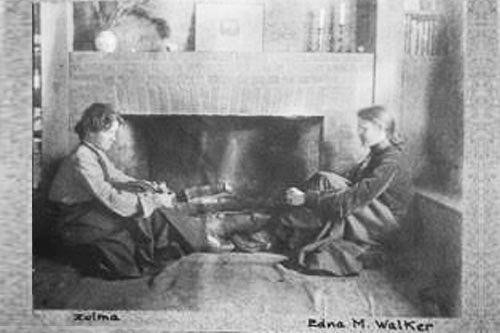

Partner Edna M. Walker
Queer Places:
The Maples (now Church At Rutland), 67 Dorr Dr, Rutland, VT 05701
Pratt Institute, 200 Willoughby Ave, Brooklyn, NY 11205
Byrdcliffe, 380 Upper Byrdcliffe Rd, Woodstock, NY 12498
Albany Rural Cemetery
Menands, Albany County, New York, USA
 Zulma Steele (July 7, 1881 - April 1, 1979) was one of the pioneering women of the
Arts and Crafts movement and
Modernism
in New York. American arts journalist for the New York Times Grace
Glueck noted that Steele was a "progressive-minded artist and artisan whose
work was considered avant-garde."[1]
When Byrdcliffe was founded, fellow Pratt students Zulma Steele and Edna M. Walker
became the chief designers of ornament for Byrdcliffe furniture aided by
Dawson Dawson-Watson.
Zulma Steele (July 7, 1881 - April 1, 1979) was one of the pioneering women of the
Arts and Crafts movement and
Modernism
in New York. American arts journalist for the New York Times Grace
Glueck noted that Steele was a "progressive-minded artist and artisan whose
work was considered avant-garde."[1]
When Byrdcliffe was founded, fellow Pratt students Zulma Steele and Edna M. Walker
became the chief designers of ornament for Byrdcliffe furniture aided by
Dawson Dawson-Watson.
Zulma Steele was born July 7, 1881 in Appletown, Wisconsin, the daughter of Zulma DeLacey Steele. She moved to Rutland, VT, around the age of 8 with her parents, who moved into Fern Cottage on the west side of Otter Creek, next to “The Maples” where her grandmother, Julia Dorr lived.
In the late 19th century, the Arts and Crafts movement grew in response to, and as rejection of, the rapid urbanization and mechanization of society during the Second Industrial Revolution. In the winter of 1902, construction of the Byrdcliffe Colony began on Mount Guardian outside of Woodstock, New York. The serene 1,500-acre commune was the brainchild of wealthy Englishman Ralph Radcliffe Whitehead. The son of a British textile Baron, Whitehead was attempting “to create a subsistence community of craftsmen,” wrote New York Times journalist Benjamin Genocchio in 2003.[2] During the beginning of art production at Byrdcliffe, activity centered around the production of furniture.
Zulma Steele was one of the first residents at the Byrdcliffe Colony and was considered one of the most talented students to come there. In 1903, she and Edna Walker, who both had recently graduated from the Pratt Institute in Brooklyn, arrived in Woodstock to work in the furniture shop.[3] Steele had long-time family ties to the Woodstock area. The two women made nature studies of local plant life for what became the iconic patterned-painted panels that were set into the larger Mission style furniture pieces. The types of objects made in the furniture shop at Byrdcliffe included tables, chairs, lamp stands, hanging shelves, bookcases, sideboards and chiffoniers. “Simple lines, delicate moldings, and planar surfaces characterized Byrdcliffe pieces and belie their solid construction,” wrote curator Peter Morrin in preparation for a 1977 exhibition on the Woodstock colonies. [4]
In 1907, the Byrdcliffe Pottery opened. Zulma Steele worked there for many years and managed the facility for the last five of those years, until its closing in 1928. She then started her own line of pottery called, “Zedware.” Steele became a lifelong resident of the Woodstock area. She was described by her contemporary, the artist Bolton Brown, as “an outstanding lady both visually and in quality we call style.”
Zulma Steele attended the 1913 Armory Show in New York City. Her immediate response to the European modern art is not known however the evolution of her art shows an impact. Professor of Art History at Bard College, Tom Wolf, noted that the "artists of Byrdcliffe practiced the most popular and accepted styles of the early twentieth century, and it is striking to see a sudden change around the time of the 1913 Armory Show."[5] During World War I, Steele worked with the Red Cross in France. She studied in Paris with the Cubist André Lhote and took classes at the Académie de la Grande Chaumière and Académie Colarossi art schools. The influences of Cubism became evident in Steele's artwork.
At the age of 45 in 1926 Zulma married Neilson T. Parker, a farmer, age 66, and they made their home at Bryrdcliffe where Zulma lived until 1967. Nelson died in 1928. She died in Westchester, NY, at 98 years of age.
My published books: